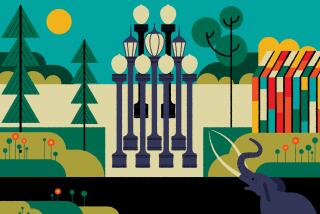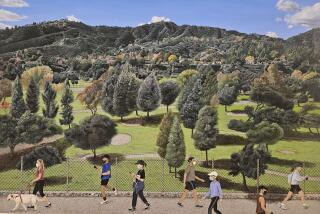‘Land of the Morning’ Fades in Light of Day
- Share via
SANTA ANA — A modest show that attempts to cover a lot of ground with relatively few objects, “Land of the Morning: Treasures of the Philippines”--at the Bowers Museum through Jan. 21--seems a rather abrupt introduction to a little-known topic.
Organized by the San Francisco Craft and Folk Art Museum, the exhibition introduces the 2,000-year tradition of Philippine folk arts with only 75 objects, most of fairly recent origin, from Bay Area collections. Viewers are likely to gain an appreciation of finely wrought textiles and delicate, winsome ornaments but only the most superficial picture of the island cultures that made them.
Granted, giving an overview of a plethora of different peoples living on hundreds of small islands and subject to diverse outside influences is no easy matter. But what’s missing is a coherent image of Philippine life and a sense of why the objects in the show look the way they do. (It seems apt that an educational videotape occupies a central position in the “Land of the Morning” gallery, providing a sense of human activity and cultural context that is hard to piece together from the exhibition itself.)
A preoccupation with linear patterns, which were often symbolic of landscape or weather conditions, and vibrant clusters of small-scale elements seems characteristic of Philippine artistry. The imagery naturally reflects indigenous animal life (monkeys, crocodiles, snakes) and a climate that supports 9,000 types of flowering plants.
The oldest objects on view are a couple of limestone burial jars from about AD 500. Carved with diamond-shaped or zigzag motifs, one is topped by a small stylized head, the other by a wistful-looking, splay-legged figure.
Other pieces predating the 16th century Spanish occupation include decorations and jewelry made of gold sheets cut into stylized animal shapes or tiny, clustered dangles.
The passion for detail remains a constant. A terra-cotta storage jar for rice made about 1930 by the Kalinga people in the northern part of Luzon Island is stamped all over with tiny circles, squiggles, Xs and other patterns. Fabrics inevitably involve vivid, densely worked designs, made by weaving or the dye-resist process called ikat.
*
Even the fly-speck columns of paleographic script etched onto bamboo tubes from Mindoro Island, dating from about 1950 (a remarkable instance of the survival of ancient learning into modern times) seem to express a cultural predilection for compacting as many tiny elements as possible into a small space.
Still, the four regions singled out in the exhibition do display certain differences, based on their geography, religious beliefs and patterns of foreign trade and domination.
*
Residents of Northern Luzon, isolated by a mountain range, preserved their rituals without outside influence until the arrival of early 20th century American missionaries. Woodcarvings from this region are particularly appealing; the grief-stricken figure on a coffin lock made by the Kankanay people in the late 19th century has a compact expressivity that looks strikingly modern.
The different cultures of Eastern Mindanao all have a penchant for personal adornment, lushly evident in boutique-worthy women’s blouses embellished with lively designs made from tiny mother-of-pearl or ceramic beads. Ivory ear ornaments, connected under the chin with a beaded chain, were prized imports worn by wealthy Bagobo men.
The Muslim cultures of Western Mindanao, forbidden to represent humans or animals in art, decorate objects from house beams to containers for betel nuts, a popular snack, with leaf-and-vine patterns.
*
Gossamer embroidered blouses of fairy-tale delicacy--made from pineapple fiber called pina--are the outstanding contributions from the Christian cultures of the lowlands. Home of 90% of the islands’ population, this central area was the most directly controlled by the Spanish during their 357-year rule.
Accordingly, the lowlands have received short shrift from ethnologists interested in more “exotic” cultures elsewhere in the islands. But the Spanish didn’t eradicate every trace of local culture; witness the talismanic cotton shirt from the Tagalog area of Luzon Island. Covered with diagrams and writings in different languages, the garment acquires its full protective powers when the wearer performs a specified ritual.
Too bad the catalog, which labors to make a case for indigenous elements of Philippine culture, is such a plodding affair, yielding no clear overview and little sense of a living culture.
When the videotape describes the sensual origin of dyes (yellow from wild ginger, black from soaking in iron-rich mud) or remarks that the Kalinga wear piles of jewelry “even for working in the fields or doing household chores,” a remote corner of the world snaps smartly into focus.
* “Land of the Morning: Treasures of the Philippines,” through Jan. 21 at the Bowers Museum, 2002 N. Main St., Santa Ana. Hours: 10 a.m. to 4 p.m. Tuesday, Wednesday and Friday through Sunday; 10 a.m. to 9 p.m. Thursday. Admission: $4.50, adults; $3, seniors and students; $1.50, children 5 to 12, free for children younger than 5. The Bowers Museum Education Department has scheduled a symposium on Philippine arts on Jan. 20 from 1 to 5 p.m. Tickets (no advance sales) are $15. (714) 567-3600.
More to Read
The biggest entertainment stories
Get our big stories about Hollywood, film, television, music, arts, culture and more right in your inbox as soon as they publish.
You may occasionally receive promotional content from the Los Angeles Times.










